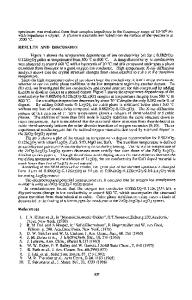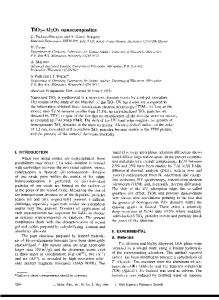Methane oxidation over Pt/Al 2 O 3 and Pd/Al 2 O 3 catalysts under transient conditions
- PDF / 357,945 Bytes
- 7 Pages / 593.972 x 792 pts Page_size
- 74 Downloads / 328 Views
Catalysis Letters, Vol. 115, Nos. 1–2, May 2007 (Ó 2007) DOI: 10.1007/s10562-007-9057-1
Methane oxidation over Pt/Al2O3 and Pd/Al2O3 catalysts under transient conditions Per-Anders Carlsson,a,* Erik Fridell,b and Magnus Skoglundha a
Competence Centre for Catalysis, Chalmers University of Technology, Goteborg SE-412 96, Sweden b IVL Swedish Environmental Research Institute, P.O. Box 5302, Goteborg SE-400 14, Sweden
Received 15 February 2007; accepted 20 March 2007
We communicate experimental results for the oxidation of methane by oxygen over alumina supported Pd and Pt monolith catalysts under transient conditions. Temperature programmed reaction (TPReaction) and reactant pulse-response (PR) experiments have been performed, using a continuous gas-flow reactor equipped with a downstream mass spectrometer for gas phase analysis. Special attention was paid to the influence of gas composition changes, i.e., O2 and H2 pulsing, respectively, on the methane conversion. For Pt/Al2O3 oxygen pulsing can significantly increase the methane conversion which can be even further improved by pulsing hydrogen instead. Such transient effects are not observed for the Pd/Al2O3 catalyst for which instead constantly lean conditions is beneficial. Our results suggest that under lean conditions Pd and Pt crystallites may undergo bulk- and partial (surface oxide formation) oxidation, respectively, which for Pd results in more active surfaces, while for Pt the activity is reduced. The latter seems to connect to a lowering of the ability to dissociate methane. KEY WORDS: catalytic methane oxidation; pulse-response experiments; periodic operation; platinum oxide; palladium oxide; Pt/Al2O3; Pd/Al2O3.
1. Introduction The huge world reserve of natural gas, which essentially is methane (CH4), appears as an attractive source of energy for heat and power production, and propulsion. The low amounts of sulphur- and nitrogen containing constituents in natural gas are beneficial and give low emission levels of sulphur and nitrogen oxides (SOx and NOx) during combustion. For efficient and environmentally sustainable conversion of methane, catalytic combustion offers an attractive alternative to conventional combustion, since the energy is released at moderate temperatures and the emission levels of carbon monoxide and nitrogen oxides are relatively low. Since methane is a greenhouse gas, such processes demand controlled methane handling with low methane slip. Moreover, the interest in natural gas fuelled vehicles (NGVs) to solve transportation issues in cities is growing since, compared to diesel engines, NGV engines produce lower amounts of NOx and particulates. Natural gas engines can operate under lean conditions keeping the fuel consumption low compared to ordinary (otto) engines running close to stoichiometric conditions. However, the methane conversion is not complete in the combustion chambers (cylinders) and thus cata-
*To whom correspondence should be addressed. E-mail: [email protected]
lytic exhaust after treatment of methane is an important
Data Loading...











